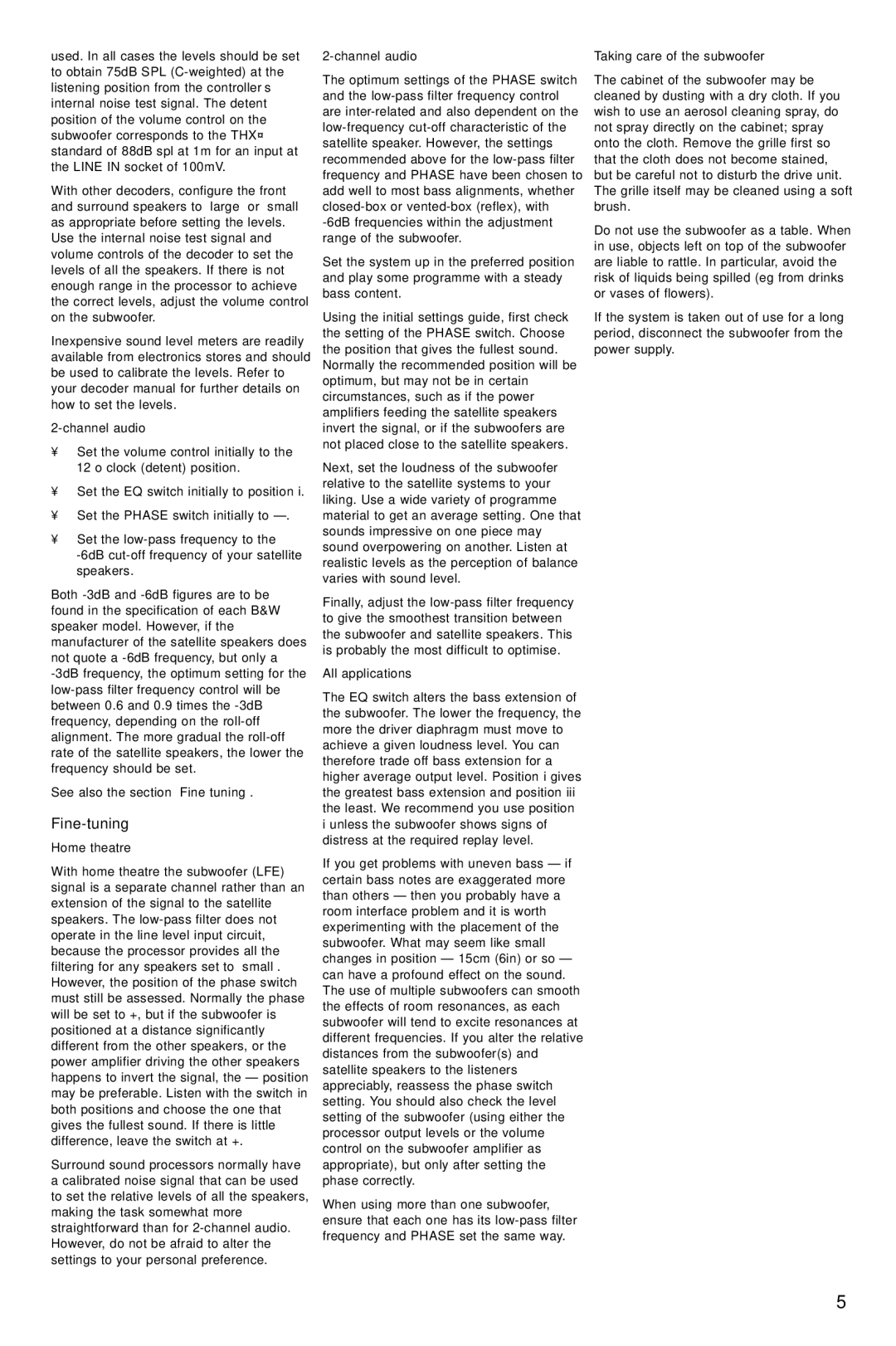used. In all cases the levels should be set to obtain 75dB SPL
With other decoders, configure the front and surround speakers to “large” or “small” as appropriate before setting the levels. Use the internal noise test signal and volume controls of the decoder to set the levels of all the speakers. If there is not enough range in the processor to achieve the correct levels, adjust the volume control on the subwoofer.
Inexpensive sound level meters are readily available from electronics stores and should be used to calibrate the levels. Refer to your decoder manual for further details on how to set the levels.
2-channel audio
•Set the volume control initially to the 12 o’clock (detent) position.
•Set the EQ switch initially to position i.
•Set the PHASE switch initially to
•Set the
Both
See also the section “Fine tuning”.
Fine-tuning
Home theatre
With home theatre the subwoofer (LFE) signal is a separate channel rather than an extension of the signal to the satellite speakers. The
Surround sound processors normally have a calibrated noise signal that can be used to set the relative levels of all the speakers, making the task somewhat more straightforward than for
The optimum settings of the PHASE switch and the
Set the system up in the preferred position and play some programme with a steady bass content.
Using the initial settings guide, first check the setting of the PHASE switch. Choose the position that gives the fullest sound.
Normally the recommended position will be optimum, but may not be in certain circumstances, such as if the power amplifiers feeding the satellite speakers invert the signal, or if the subwoofers are not placed close to the satellite speakers.
Next, set the loudness of the subwoofer relative to the satellite systems to your liking. Use a wide variety of programme material to get an average setting. One that sounds impressive on one piece may sound overpowering on another. Listen at realistic levels as the perception of balance varies with sound level.
Finally, adjust the
All applications
The EQ switch alters the bass extension of the subwoofer. The lower the frequency, the more the driver diaphragm must move to achieve a given loudness level. You can therefore trade off bass extension for a higher average output level. Position i gives the greatest bass extension and position iii the least. We recommend you use position i unless the subwoofer shows signs of distress at the required replay level.
If you get problems with uneven bass – if certain bass notes are exaggerated more than others – then you probably have a room interface problem and it is worth experimenting with the placement of the subwoofer. What may seem like small changes in position – 15cm (6in) or so – can have a profound effect on the sound. The use of multiple subwoofers can smooth the effects of room resonances, as each subwoofer will tend to excite resonances at different frequencies. If you alter the relative distances from the subwoofer(s) and satellite speakers to the listeners appreciably, reassess the phase switch setting. You should also check the level setting of the subwoofer (using either the processor output levels or the volume control on the subwoofer amplifier as appropriate), but only after setting the phase correctly.
When using more than one subwoofer, ensure that each one has its
Taking care of the subwoofer
The cabinet of the subwoofer may be cleaned by dusting with a dry cloth. If you wish to use an aerosol cleaning spray, do not spray directly on the cabinet; spray onto the cloth. Remove the grille first so that the cloth does not become stained, but be careful not to disturb the drive unit. The grille itself may be cleaned using a soft brush.
Do not use the subwoofer as a table. When in use, objects left on top of the subwoofer are liable to rattle. In particular, avoid the risk of liquids being spilled (eg from drinks or vases of flowers).
If the system is taken out of use for a long period, disconnect the subwoofer from the power supply.
5
